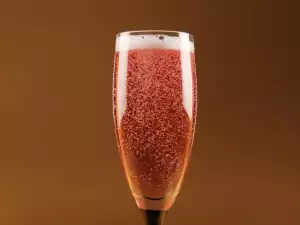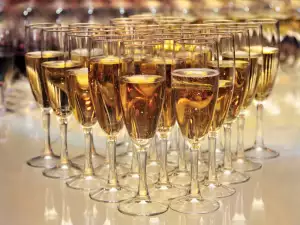Sparkling wine is a type of wine where carbon dioxide has been artificially added. That is the source of the many small bubbles and origin of the "sparkling" name.
As a sparkling wine, aerated sparkling wine is very similar to Champagne but differs in the production process.
Champagne is a sparkling wine produced in the territory of the Champagne region of France. Natural sparkling wines are those where the natural process of the 2nd fermentation has produced carbon dioxide, leading to their carbonation.
In aerated sparkling wines, the process is the same but instead of occurring naturally over several weeks, it is induced by adding sugar and yeast which lead to the wine's carbonation.
Production of Sparkling Wine
The grapes intended for sparkling wines need to be harvested earlier than the ones used for regular wines. The reason for this is that an earlier harvest has a higher acidity.

For sparkling wine production it is not good for the grapes to have high sugar levels. That is why only certain varieties are selected - Blanc de blanc or Chardonnay, where the quantity of tannins and other phenolic compounds is low.
Picking of the grapes must be done by hand, not mechanically, to keep the fruits intact. Then the grapes are pressed, the skins removed and the grapes are left to ferment.
The 1st fermentation of sparkling wine occurs naturally. The crucial moment there is the so-called malolactic fermentation - a reaction that happens using lactic acid bacteria.
Afterwards, the 2nd fermentation is caused by one of the most common methods used for it.
The most widely known and traditional method for inducing the 2nd fermentation is adding sugar and yeast to the wine. These 2 products form carbon dioxide in the alcohol and essentially carbonate it.
The 2nd way is by taking a small part of the wine and mixing it with sugar syrup. The mixture adjusts the sweetness level and when added to the rest of the wine it carbonates it.
The 3rd method is known as Charmat, where the 2nd fermentation needs to occur in stainless steel containers, with fresh yeast and sugar added to the wine.
After the 2nd fermentation concludes, the sparkling wine is cooled and bottled at high pressure - at a temperature of 70°F (20°C) at 3 bars of pressure.
The bottles need to be closed with a wooden or plastic cork. Once opened, carbon dioxide is released and the wine becomes sparkly. The alcohol by volume is usually between 10 and 12%.
History of Sparkling Wine
One legend goes that the 1st sparkling wine was created by a blind monk named Pierre Pérignon some 400 years ago. He actually stood guard over the wineries but would pour himself a bit of the wine to take with him to his cell and ended up accidentally discovering the method of production.
Others believe that this is more of a fictional fabrication than a real historical event, saying that sparkling wines have been produced since classical antiquity.
Types of Sparkling Wine
Based on color:
- red
- white
Based on the added sugar:
- extra brut
- brut
- extra dry
- semi-dry
- dry
- semi-sweet
- sweet

Serving Sparkling Wine
Sparkling wine is served slightly cooled at a temperature of about 40°F (6°C). Like champagne and aerated sparkling wine, it can be placed in an ice bucket to cool.
The bottle must be opened in front of the guests and poured into thin-walled glasses in the shape of a flute or upside down cone with a medium tall stem, allowing for the best possible view of the bubbles.
When pouring in the sparkling wine, the glass needs to be at an angle, touching the mouth of the bottle so that the wine trickles onto the side of the glass first and not directly to the bottom. This reduces the carbonation and foam that forms in the glass.
Foods That Complement Sparkling Wine
Sparkling wine is served either with the aperitif or with the dessert. All types of cheeses and fish are appropriate for it. Sushi, fried and crunchy foods make for a good combination, as well as delicacies normally served with an aperitif.
The wine also makes an excellent complement to creme caramel, cheesecake, coconut cake, chocolate mousse, chocolate, biscotti, tiramisu, biscuit cake, creme brulee, Agnes cakes, ice cream, ice cream cake and rolls.
Many fruits also go well with sparkling wine - apples, pears, apricots, oranges, quinces, bananas and strawberries.





















